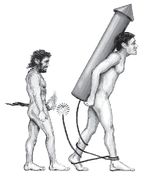The Darwin Awards Countdown to Extinction (4 page)
Read The Darwin Awards Countdown to Extinction Online
Authors: Wendy Northcutt

BOOK: The Darwin Awards Countdown to Extinction
13.48Mb size Format: txt, pdf, ePub
I stood there dazed, the smell of fruitcake and burnt hair filling the air.
Remembering my previous flambé, I sighed and reached toward the stove. I started to say, “Dad, you have to cook it that low, alcohol . . .” But all I had uttered was, “Dad . . .” when my hand touched the knob. There was this loud
WHOMP
! The oven door blew open and a sheet of blue flame shot straight up out of it, burning
all
the hair off my arm—which never grew back!
WHOMP
! The oven door blew open and a sheet of blue flame shot straight up out of it, burning
all
the hair off my arm—which never grew back!
I stood there dazed, the smell of fruitcake and burnt hair filling the air, my dad with a look of utter shock on his face. Before heading to the ER, which he was nice enough to take me to, I managed to finish my sentence: “Alcohol burns.”
A nd
you
tr y explaining to the ER that your fruitcake exploded . . .
you
tr y explaining to the ER that your fruitcake exploded . . .
Reference: Chad Peters, in loving memory of his father, Harold Peters

Reader Comments
“More than one fruitcake in that kitchen.”
“Now we know why fruitcake is lucky.”
A concerned reader pointed out: “This doesn’t fill the bill, since the independent actions of two people who didn’t communicate fast enough were not, taken separately, stupid acts on the part of either.” The reader is correct. Since no self-selection is evident in The Great Fruitcake Incident, the son would
not
earn a Darwin Award if things had turned out badly.
not
earn a Darwin Award if things had turned out badly.
Confirmed by Darwin
Featuring food, work, and an oven
FEBRUARY 2009, SWEDEN | Welcome to Sweden, home of Swedish massage, Swedish fish, and one Swedish meatball who de - cided to warm himself in an industrial-strength oven. The incident took place during a freezing February at a facility operated by a maker of kitchen cabinets and fixtures.
The heating system in the loading area had ceased to function, leaving a shivering truck driver defenseless against the frigid winter. Looking to escape the cold, this driver wandered toward the large oven used for shrink-wrapping and asked the operator if he could take a spin on the oven’s conveyor belt to get warm! Although the driver was freezing his umlaut off, the hard-hearted operator denied the man’s request.
Undaunted, the driver waited until no one was looking and managed to hoist himself onto the conveyor belt for a blissful, toast y ride. But all those Swedish smorgasbords had taken their toll. The massive trucker was too heavy for the belt and the motor shut down, leaving him stuck in the 180°C (360°F) oven!
Undaunted, the driver waited until no one was looking . . .
Luckily the oven operator noticed the stoppage and was able to rescue the man from the searing heat before he sustained serious damage. Following the incident, Sweden’s Work Environment Authority offered the oven operator counseling to work through the shock he suffered and intends to carry out a risk assessment of surveillance around the shrink-wrap ovens. Apparently they are too tempting to leave unguarded.

Reference: Fox News,
thelocal.se
thelocal.se

Reader Comments
“Talk about a hot and cold personality!”
“Hot stuff.”
“Hot lips!”
“Hot stuff.”
“Hot lips!”
For the scientific or artistic mind, a shrink-wrap oven offers fascinating possibilities. The unfortunate masses who do not own an expensive shrink-wrap oven can use household appliances such as a hair dryer to good effect. For those with sufficient courage and an oven broiler, an empty potato chip bag can be reduced to the size of a postage stamp—with the words
still legible
in miniature! An intriguing glimpse into the world of home shrink-wrap experimentation:
still legible
in miniature! An intriguing glimpse into the world of home shrink-wrap experimentation:
How to Shrink a Bag of Chips
Unconfirmed Personal Account
Featuring food and a hammer
2010 | Ray and I are great fans of zombie movies and have passed many a late night in front of the TV with popcorn and DVDs. Ever since reading the
Zombie Survival Guide
by Max Brooks, Ray is convinced that hordes of the undead will one day rise up. While trying to convince me of the impending apocalypse, Ray cited two facts that I found to be in error.
Zombie Survival Guide
by Max Brooks, Ray is convinced that hordes of the undead will one day rise up. While trying to convince me of the impending apocalypse, Ray cited two facts that I found to be in error.
1. The human skull is one of the hardest surfaces in nature.
2. A medieval mace lacks the stopping power to crush it.
We argued these points for half an hour, without coming to an agreement.
The next morning Ray texted me to come over and settle the issue. He answered the door wearing a cycle helmet and led me to the backyard, where he handed me a lump hammer (a small sledge) and told me to hit him over the head. I don’t know if the helmet would have stopped the hammer blow or not, and I wasn’t about to try it on my friend. Instead I devised a simple experiment, hoping to avoid any nasty injuries.
Ray and I went to the supermarket to buy two coconuts, one for the experiment and one because I really like coconut. We returned to the backyard and proceeded to place a coconut on the paving. I picked up the lump hammer and with one solid blow, reduced the coconut to delicious shrapnel. As I was clearing up the shards of nutt y goodness, I said, “If that was your head, you’d be dead.”

SILLY SCIENCE
Zombies eat people. But do zombies eat dead people? According to Matt Mogk at the Zombie Research Society, the answer is important. If zombies continue feeding after their victims are dead, then they are effectively destroying their own reinforcements. That would be a Darwinian move.
I turned to see Ray trying to validate my theory—by head butting the second coconut as hard as he could! Ray was fine after a few stitches, thankfully not a Darwin Award winner this time, but I’ll keep you posted.
Incidentally Ray was vindicated. He did manage to crack the nut with a head butt. Since he proved that his skull is indeed harder than a coconut, my experiment was inconclusive.
Reference: Pete Copping

Reader Comments
“The unbearable hardness of being.”
“Jesus was a Zombie!”
SCIENCE INTERLUDE THE MYSTERY OF SUPER-TOXIC SNAKE VENOM
By Michael Wall
(who managed to write this whole essay without using the word
snakebite
even once!)
snakebite
even once!)
Too Much of a Nasty Thing?
On March 4, 2008, a juvenile black mamba bit Nathan Layton as he hiked in the bush west of South A frica’s Kruger National Park. The twenty-eight-year-old Englishman was training to be a game ranger and was in good shape, yet he sank into a coma almost immediately and died within an hour. Layton is not under consideration for a Darwin Award—he was just unlucky enough to get nailed by one of the world’s most dangerous snakes.
Black mambas are fast, agile, nervous, and big, reaching lengths up to fourteen feet. Among venomous snakes, only the king cobra grows longer. Mambas and cobras, their hooded cousins, belong to the family Elapidae and share a potent neurotoxic venom. Its effects are dramatic. A victim’s neurons no longer transmit messages, mus - cles fail to respond to the simplest command, and bitten animals asphy xiate as the venom scrambles nerve signals that tell the diaphragm to expand and contract.

Kill Bill
, a macabre comedy film, features assassins named after deadly snakes: Black Mamba, Cottonmouth, Copperhead, and Sidewinder. Two thumbs-up for Tarantino’s powerful ode to motherhood.
, a macabre comedy film, features assassins named after deadly snakes: Black Mamba, Cottonmouth, Copperhead, and Sidewinder. Two thumbs-up for Tarantino’s powerful ode to motherhood.
As Layton’s quick death indicates, black mamba venom is powerful: The venom from a single bite can kill 9,400 lab mice. But mambas aren’t the toxicity champs, not by a long shot; at least twenty-two other snakes pack more of a wallop. At the top of the list is Australia’s inland taipan. This shy, inoffensive serpent—which the late Steve Irwin let tongue-flick his cheek on one episode of
The Crocodile Hunter
—can snuff out 100,000 lab mice with the venom from a single bite.
The Crocodile Hunter
—can snuff out 100,000 lab mice with the venom from a single bite.
Other books
Moffie by Andre Carl van der Merwe
Havana Blue by Leonardo Padura
Swimming Lessons by Athena Chills
For Reasons Unknown by Michael Wood
Remembering Phoenix by Randa Lynn
Embracing Emma (Companion to Brisé) by Leigh Ann Lunsford
Ben the Dragonborn by Dianne E Astle
The Bitter Taste of Victory by Lara Feigel
Bluegrass Seduction (The Bluegrass Billionaire Trilogy Book 1) by Alice Ward, Jessica Blake
Into the Triangle by Amylea Lyn